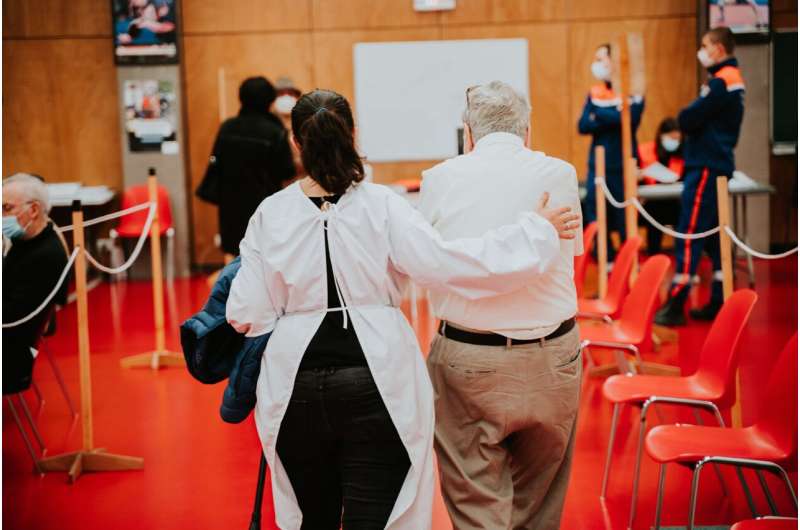Two years after infection, half of people hospitalized with COVID-19 have at least one symptom, follow-up study suggests


Two years after infection with COVID-19, half of patients who were admitted to hospitals still have at least one symptom, according to the longest follow-up study to date, published in The Lancet Respiratory Medicine. The study followed 1,192 participants in China infected with SARS-CoV-2 during the first phase of the pandemic in 2020.
While physical and mental health generally improved over time, the analysis suggests that COVID-19 patients still tend to have poorer health and quality of life than the general population. This is especially the case for participants with long COVID, who typically still have at least one symptom, including fatigue, shortness of breath, and sleep difficulties two years after initially falling ill.
The long-term health impacts of COVID-19 have remained largely unknown, as the longest follow-up studies to date have spanned around one year. The lack of pre-COVID-19 health status baselines and comparisons with the general population in most studies have also made it difficult to determine how well patients with COVID-19 have recovered.
Lead author Professor Bin Cao, of the China-Japan Friendship Hospital, China, says, “Our findings indicate that for a certain proportion of hospitalized COVID-19 survivors, while they may have cleared the initial infection, more than two years is needed to recover fully from COVID-19. Ongoing follow-up of COVID-19 survivors, particularly those with symptoms of long COVID, is essential to understand the longer course of the illness, as is further exploration of the benefits of rehabilitation programs for recovery. There is a clear need to provide continued support to a significant proportion of people who’ve had COVID-19, and to understand how vaccines, emerging treatments, and variants affect long-term health outcomes.”
The authors of the new study sought to analyze the long-term health outcomes of hospitalized COVID-19 survivors, as well as specific health impacts of long COVID. They evaluated the health of 1,192 participants with acute COVID-19 treated at Jin Yin-tan Hospital in Wuhan, China, between January 7 and May 29, 2020, at six months, 12 months, and two years.
Assessments involved a six-minute walking test, laboratory tests, and questionnaires on symptoms, mental health, health-related quality of life, whether they had returned to work, and health care use after discharge. The negative effects of long COVID on quality of life, exercise capacity, mental health, and health-care use were determined by comparing participants with and without long COVID symptoms. Health outcomes at two years were determined using an age-, sex-, and comorbidities-matched control group of people in the general population with no history of COVID-19 infection.
The median age of participants at discharge was 57 years, and 54% (n = 641) were men. Six months after initially falling ill, 68% (777/1,149) of participants reported at least one long COVID symptom. By two years after infection, reports of symptoms had fallen to 55% (650/1,190). Fatigue or muscle weakness were the symptoms most often reported and fell from 52% (593/1,151) at six months to 30% (357/1,190) at two years. Regardless of the severity of their initial illness, 89% (438/494) of participants had returned to their original work at two years.
Two years after initially falling ill, patients with COVID-19 are generally in poorer health than the general population, with 31% (351/1,127) reporting fatigue or muscle weakness and 31% (354/1,127) reporting sleep difficulties. The proportion of non-COVID-19 participants reporting these symptoms was 5% (55/1,127) and 14% (153/1,127), respectively. COVID-19 patients were also more likely to report a number of other symptoms including joint pain, palpitations, dizziness, and headaches. In quality of life questionnaires, COVID-19 patients also more often reported pain or discomfort (23% [254/1,127]) and anxiety or depression (12% [131/1,127]) than non-COVID-19 participants (5% [57/1,127] and 5% [61/1,127], respectively).
Around half of study participants (650/1,190) had symptoms of long COVID at two years, and reported lower quality of life than those without long COVID. In mental health questionnaires, 35% (228/650) reported pain or discomfort and 19% (123/650) reported anxiety or depression. The proportion of COVID-19 patients without long COVID reporting these symptoms was 10% (55/540) and 4% (19/540) at two years, respectively. Long COVID participants also more often reported problems with their mobility (5% [33/650]) or activity levels (4% [24/540]) than those without long COVID (1% [8/540] and 2% [10/540], respectively).
Mental health assessments of long COVID participants found 13% (83/650) displayed symptoms of anxiety and 11% (70/649) displayed symptoms of depression, while for non-long COVID participants the proportions were 3% (15/536) and 1% (5/540), respectively. Long COVID participants more often used health care services after being discharged, with 26% (169/648) reporting an outpatient clinic visit compared to 11% (57/538) of non-long COVID participants. At 17% (107/648), hospitalization among long COVID participants was higher than the 10% (52/538) reported by participants without long COVID.
Source: Read Full Article